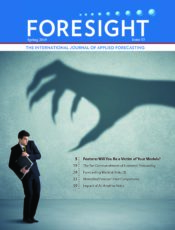Special Feature Section
 Our special feature section in this 53rd issue of Foresight poses the question, Are You a Victim of Your Models? Here Tom Willemain, a longtime contributor to the journal, ponders why modeling and optimization algorithms haven’t displaced “gut instinct” in supply-chain forecasting as much as one would expect, given their penetration in kindred fields such as finance. It’s not that we can always trust models —far from it—but, as Tom puts it,
Our special feature section in this 53rd issue of Foresight poses the question, Are You a Victim of Your Models? Here Tom Willemain, a longtime contributor to the journal, ponders why modeling and optimization algorithms haven’t displaced “gut instinct” in supply-chain forecasting as much as one would expect, given their penetration in kindred fields such as finance. It’s not that we can always trust models —far from it—but, as Tom puts it,
What makes gut instinct dangerous is that it is so amorphous. Everyone who works a long time in a job develops instincts, but longevity is not the same as wisdom. It is possible to learn all the wrong lessons.
Tom then provides a capsule summary of the advantages of modeling, but with the caveat that model error is a constant risk that requires monitoring and careful checking of its assumptions.
The theme is more fully developed in the several commentaries that follow. Chris Gray argues that there are more basic questions we need to ask: “Are we forecasting the items that we should be forecasting and not forecasting items that should be handled a different way?” “If we rely on statistical models and those models fail us, who will be willing to be held accountable?” Chris’s full list exposes the many problems with reliance on models for supply-chain forecasting.
Paul Goodwin observes that it’s easy to understand how analysts can fall in love with their models: “After all, they require an investment of time and effort, they provide evidence to the world of one’s technical ingenuity, and they may have a pleasing aura of internal elegance.” But given the reality of reliance on forecasting software purchased from commercial vendors, forecasters can lose their “sense of proprietorship” of the software’s methods and become all too willing to override model-based forecasts based on their gut feel. A straightforward but underutilized approach in supply chain is that of combining forecasts, whose virtues Paul extols.
David Orrell succinctly explains why models can be abused, noting that “while in principle the equations may be explicit and instructive, in practice models often become so very complicated that it is hard for even their designers to figure out how they work, let alone communicate them to a general audience.”
Henry Canitz reminds us that “one of the biggest hurdles in moving away from ‘gut feel’ and toward using advanced models is the availability of consistent and accurate data and that models built on poor data lead to poor decisions, which in turn lead to mistrust in the models and the systems on which they run. And soon we’re back relying on someone’s gut feel.” Hank is a proponent of digitizing supply-chain information and utilizing digital twins to capture a picture of how well the supply-chain network is working.
John Boylan and Aris Syntetos emphasize that the value of modeling can be undermined by conflicting business objectives, data not purged of errors, manipulation of model parameters, and forecasters who are overconfident in their own judgments.
The special feature section concludes with Tom Willemain’s responses to the various commentaries.
And Elsewhere in This Issue...
Azhar Iqbal is Director of Wells Fargo Securities LLC, which has won awards for forecasting of macro and financial variables. Dr. Iqbal and former director John Silvia present their Ten Commandments of Economic Forecasting and explain how these guide the forecasting process at Wells Fargo.
A feature of Foresight’s Winter 2019 issue was Spyros Makridakis and colleagues’ article on “Predicting Medical Risks and Appreciating Uncertainty.” After summarizing the key points of that article, we offer commentaries from John Ioannidis in Medical Science and Practice: Does Anyone Want to Fix Them? and Nassim Nicholas Taleb’s Medicine and Risk Transfer, both of which enumerate serious shortcomings of medical practice. We can appreciate these equally from the perspectives of forecasters and patients.
Shaun Snapp then discusses some organizational realities of forecast-error measurement, and argues that to drive forecast-accuracy improvement we need to make Monetized Forecast-Error Comparisons, for which he offers a new, free application.
The Spring 2019 issue concludes with a new section on artificial intelligence. Following our 2017-18 five-part article from Spyros Makridakis — Forecasting the Impact of Artificial Intelligence — Larry Vanston presents another voice on this issue, concentrating on where his thinking parts ways with Spyros’s predictions. Then, after giving Spyros an opportunity to respond, we feature an interview with Larry in this issue’s installment of Forecaster in the Field.
Foresight’s full coverage of the AI articles and commentaries is available in a single publication: our new Foresight Guidebook on AI.
2019 Foresight Practitioner Conference

The 2019 Foresight Practitioner Conference will be held November 13-14 at the Rizzo Center in Chapel Hill, NC. The theme this year is "Artificial Intelligence -- The Hype and the Promise for Forecasting and Planning."
Find pricing and registration at: foresight.forecasters.org/2019-conference.

